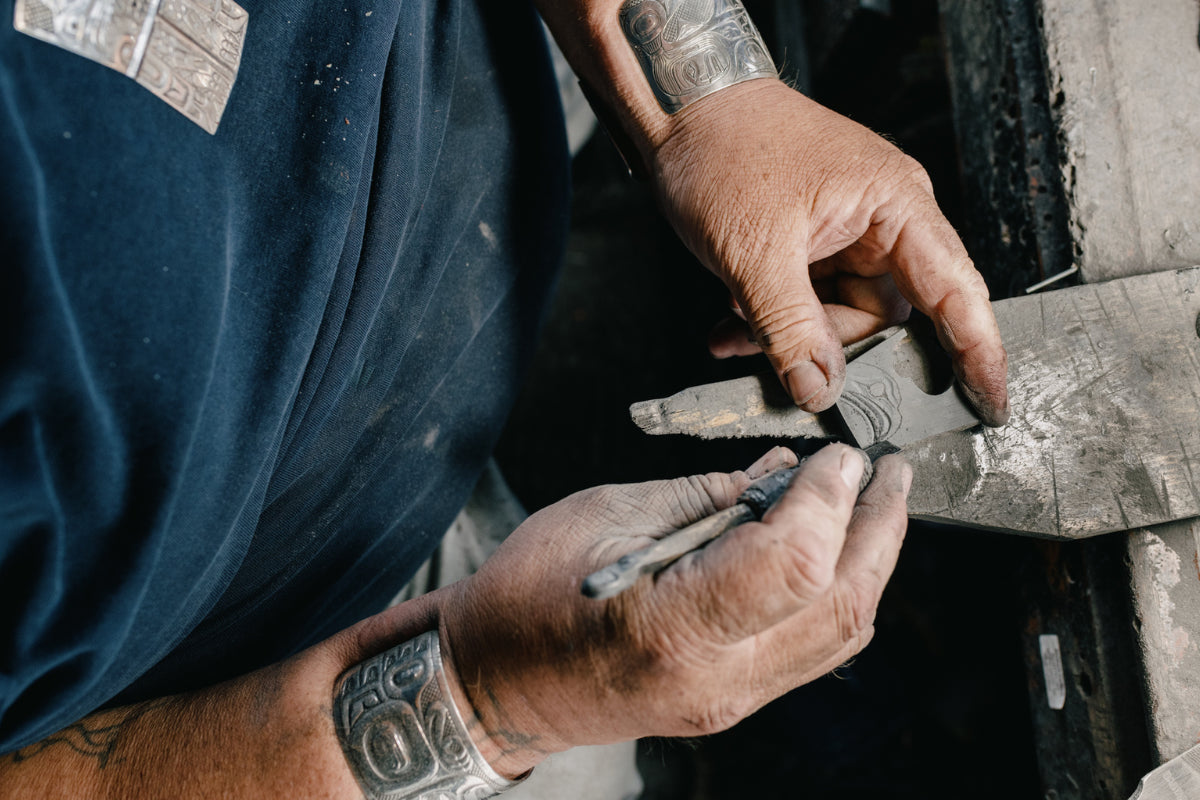Your Cart is Empty
What is argillite?
Argillite is a black stone that is geologically classified as slate. The argillite from Haida Gwaii is found on only one mountaintop and is protected by the Haida Nation as a stone exclusively carved by the Haida people.The journey to the argillite deposit is a treacherous hike, and is accessible only by the Haida people. It is recognizable by its black pigment and shiny exterior when carved. When unpolished, argillite is rough and matte.
What is argillite used for?
The Haida have used and carved argillite for thousands of years. Argillite in Xaayda Kil (the southern dialect of the Haida Language) is HlGaa K’id which translates literally to rock carve. Argillite is a composition of clay particles, making it impractical to use as a tool like other stones.
Some early uses of argillite by the Haida include the use of argillite by Haida argillite carvers who would scale their gyaaGang house frontal poles using argillite miniatures maquettes before carving the larger poles out of monumental red cedars. These miniature gyaaGang were amongst the first items to be traded when European ships first visited Haida Gwaii. This quickly became a popular trade between the two peoples. Argillite carving has continued to evolve, becoming a culturally significant and much revered art form of the Haida people. Sole rights to this precious stone are owned by the Haida people, making argillite a unique hallmark of traditional Haida artwork and carvings.

Argillite Eagle by late Haida Artist, Myles Edgars
How is argillite carved?
Argillite is carved carefully using hand tools like chisels and small gauge knives. The tools used to carve argillite are handmade by the carvers themselves. The carving process is one of thought and careful consideration. Each carving is uniquely chosen based on the shape of the selected piece of argillite. The grain of the stone is used to determine the features of each particular carving. It is important to ensure that the grain of the argillite piece will correspond with and enhance the intended design. Designs themselves are based upon the piece being carved.
Raven Steals the Light argillite carving by Haida argillite carver, Michael Brown.
How to care for argillite:
Although argillite is renowned for its durability and easy to wear qualities, there are some important things to know about caring for your argillite piece. Argillite is fairly hard and sturdy stone. It is durable enough to wear as a piece of jewelry or to keep as a collector carving for generations, but the softness of argillite allows fine details and features to be carved into the stone.
- Argillite needs to be handled carefully. It is durable enough to wear daily, but will potentially crack, chip, or break if dropped or hit against something hard, like glass or tile. Things to note:
- Do not drop your piece, and be very careful when placing or displaying your piece on a hard surface. It is recommended that you store your argillite on a soft surface, and in a constant temperature. Exposing argillite to high and low levels of heat and high levels of humidity could destabilize the stone.
- We advise that while wearing argillite jewelry, you do not layer your piece with other metal necklaces or carvings. To ensure that your argillite jewelry remains in the best condition, do not wear it while swimming or in the shower, and do not expose it to excess water.
- Argillite is enhanced by the wearer. Your body’s natural oils will contribute to argillite’s shine as you touch and wear it. It is not recommended to clean argillite often, however, for periodic cleaning, argillite can be very delicately dusted with a dry cloth, q-tip or paper towel.
Now that you know all about the stone of Haida Gwaii shop our collection of argillite, online or in store!
Have something specific in mind? Get a commissioned piece!


 Argillite Octopus Women by Haida artist,
Argillite Octopus Women by Haida artist, 



